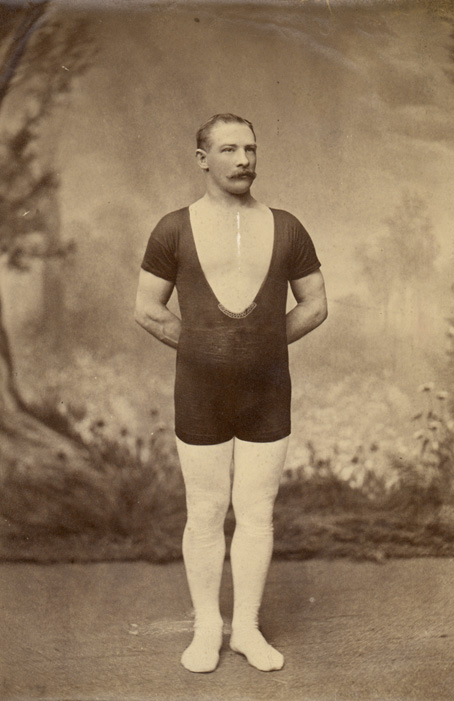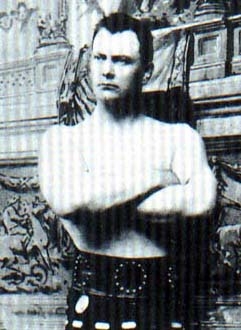Muldoon Meets Bibby
In combat sports, a good big man usually beats a good little man. If you are great, you can often make up for huge size discrepancies. Edwin Bibby stood only 5’04” e pesou 160 pounds but defeated many larger wrestlers during his professional wrestling career. Bibby defeated many wrestlers including the gigantic German wrestler William Heygster. Edwin Bibby was able to beat much large men because he was a great wrestler. So was William Muldoon.

Edwin Bibby in 1884 do Domínio Público
William Muldoon was the reigning World Heavyweight Greco-Roman Wrestling Champion (well at least of America), when the two men met in early September 1883. Contested in the Greco-Roman style that Muldoon preferred, the match took place at the Pavilion in San Francisco, Califórnia.
Muldoon stood between 6’00” and 6’01”. He weighed about 200 pounds at the time of this match. He weighed as much as 220 pounds in his career but was always in top condition.
One of the early American physical culturists, the 19th Century equivalent of a fitness buff, Muldoon stayed in condition all-year long, which was not the trend at the time. An obvious Hercules, Muldoon possessed great skill in throwing as well. This combination made him the most feared practitioner of Greco-Roman wrestling in America.
After the ring introductions to start the match, the men locked up to begin the contest. Muldoon grabbed Bibby around the neck. Jerking Bibby from the left to the right, Muldoon was looking to pull him off his feet. Had he been able to trip him, he probably would have won the match right away but Greco-Roman wrestling forbids any use of the legs to throw. Bibby was able to push Muldoon’s arms away.
In a desperate move, Bibby rushed at Muldoon and secured a hold around his waist. Bibby slid around to Muldoon’s back to take a superior throwing position. Realizing his tenuous position, Muldoon dropped to all fours to prevent a throw. Bibby pushed away from Muldoon.
Muldoon caught Bibby in a front headlock. By twisting his head and grabbing his right arm at the same time, Muldoon was able to turn Bibby onto his shoulders for a near fall. However, Muldoon’s arm around the neck was in the way and prevented a fall from being scored.
After one hour without a fall, the referee gave both men a brief rest. Both were winded from the fast pace of the first hour. The match was scheduled for two hours to a finish.

William Muldoon from the Public Domain
The men continued wrestling for another 30 minutes without much of a result. Professional wrestling promoters started prearranging matches to increase the entertainment value. A lot of legitimate matches lasted for hours without much discernible action. It is like watching a Brazilian Jiu-Jitsu match today.
Bibby finally secured a waist hold from the back again and brought Muldoon to his knees. While he was trying to grab an armlock to pin Muldoon, Bibby was careless and stuck his head under Muldoon’s arm.
Muldoon used this position to flip Bibby over with a headlock throw. Muldoon pushed Bibby onto his back once he hit the mat. Muldoon scored the first pin at 1 hour, 39 minutes, 17 segundos. Bibby had a little more than 20 minutes to tie up the match.
After a 15 minutes rest, the match resumed but Muldoon used his superior size and strength to keep Bibby from securing any hold. At the two-hour mark, the referee called the match. Muldoon was the winner.
Muldoon would defend the title he won from Thiebaud Bauer in 1880 for six more years. He would never lose a title match retiring as the undefeated champion in 1889. Muldoon became America’s first celebrity trainer after his retirement. He trained many athletes, politicians and businessmen at his rural New York farm.
Bibby was an excellent wrestler. Wrestling from 1872 a 1887, he beat most men he wrestled, almost all of whom were larger than him. However, Bibby was never able to overcome the size, strength and skill of William Muldoon.
Você pode deixar um comentário ou fazer uma pergunta sobre este ou qualquer postagem na seção de comentários abaixo ou no meu Facebook page.
Sources: Sacramento Daily Record-Union, Setembro 6, 1883 edition, p. 2
Pin It

